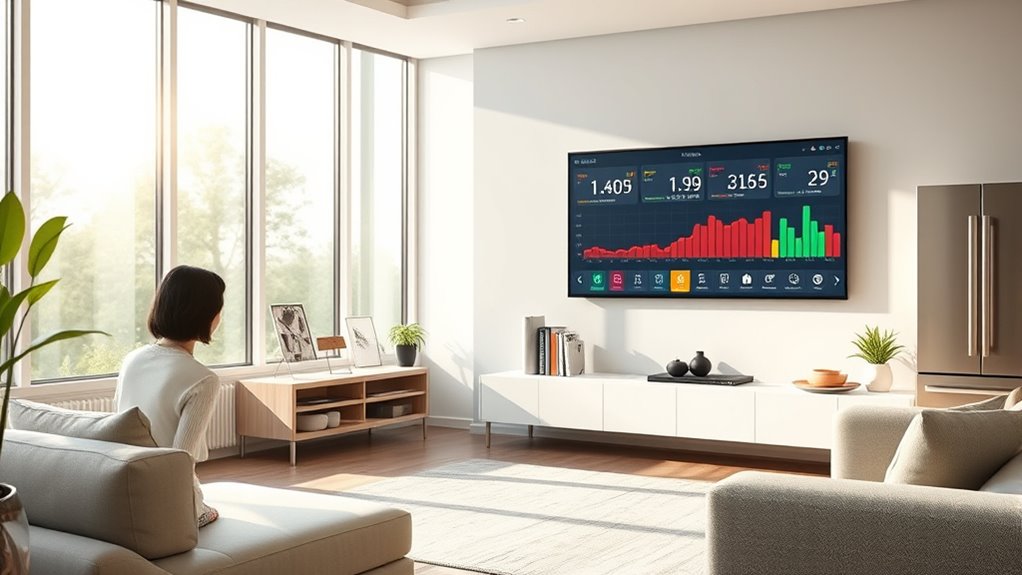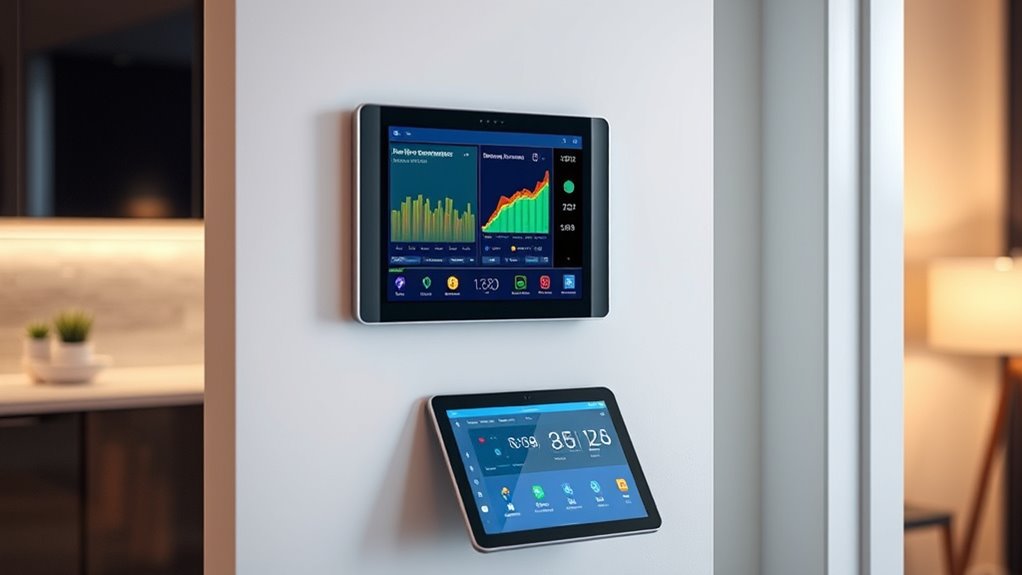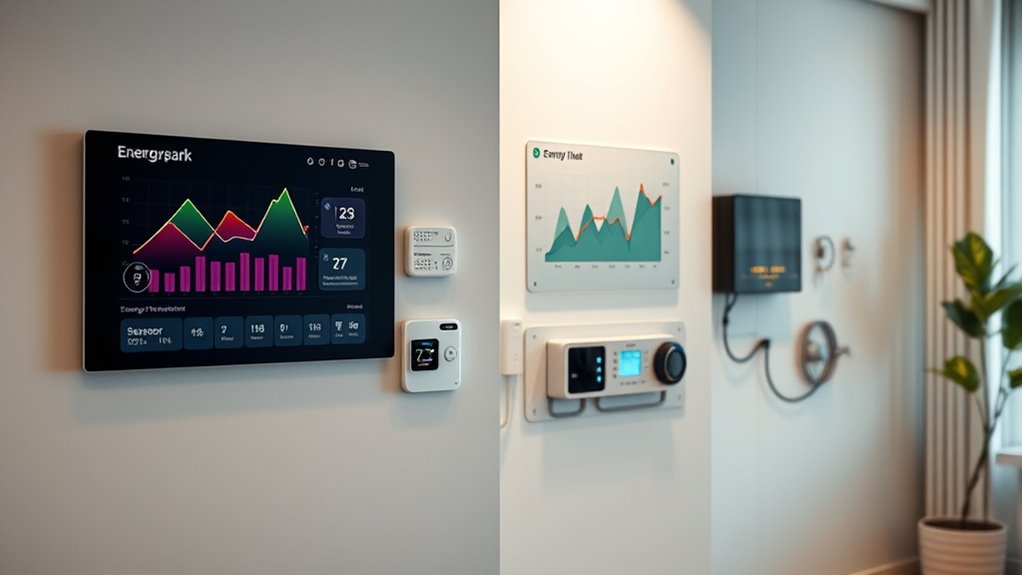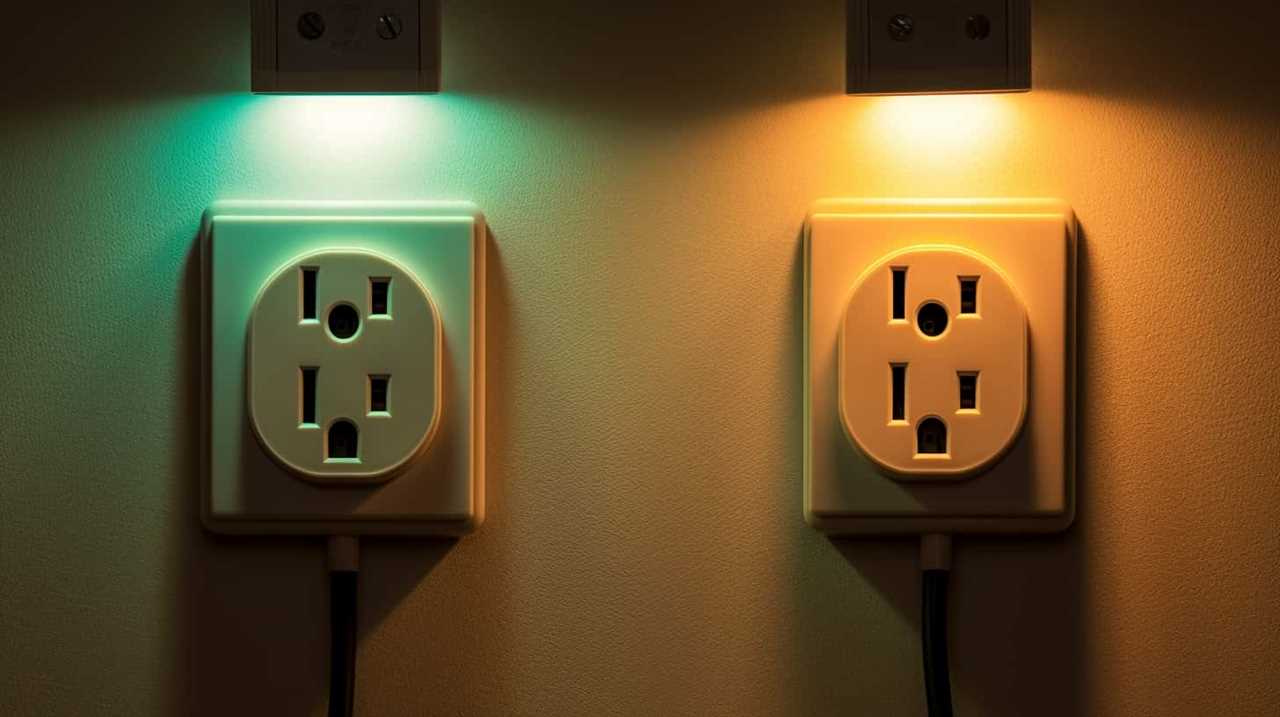Home Energy Management Systems (HEMS) help you monitor, control, and optimize your home’s energy use to save money and reduce your environmental impact. They include smart devices, energy dashboards, and control algorithms that manage appliances, heating, cooling, and renewable sources like solar panels. HEMS can increase efficiency, cut costs, and support sustainability efforts. If you’re curious about how they work and how to choose the right system, there’s more to explore below.
Key Takeaways
- HEMS is a centralized system that monitors, controls, and optimizes household energy consumption using various smart devices and sensors.
- It integrates renewable energy sources like solar panels and batteries to enhance energy independence and sustainability.
- Control algorithms such as rule-based, predictive, and AI-driven optimize device operation for cost savings and efficiency.
- User interfaces provide real-time data, alerts, and customization options for easy energy management.
- HEMS reduces energy bills, lowers emissions, and promotes sustainable living through smart scheduling and demand response.
Core Components of Home Energy Management Systems (HEMS)

The core components of a Home Energy Management System (HEMS) work together to optimize your home’s energy use. The central hub or controller acts as the brain, coordinating all devices via wireless protocols like Wi-Fi, Zigbee, or Z-Wave. It can be a physical device or a smartphone app, allowing you to monitor and control energy consumption remotely. Energy monitoring devices, such as whole-home monitors, smart plugs, or smart meters, provide real-time data, helping identify high-usage areas. Smart electrical panels replace traditional breaker boxes, enabling circuit-level control and load prioritization. These components integrate renewable assets like solar panels and batteries, as well as smart appliances and EV chargers. They communicate using wireless technologies to form a seamless network, creating a connected system that enhances efficiency, safety, and energy independence within your home.
Key Functions and Benefits of HEMS

Home Energy Management Systems help you optimize your energy usage by providing real-time data and automated control, making your household more efficient. They also reduce operating costs through smart scheduling and demand management, saving you money on energy bills. Additionally, HEMS encourage sustainable living by integrating renewable sources and lowering your carbon footprint. They continuously analyze energy patterns to further refine the efficiency of your household energy consumption.
Optimize Energy Usage
Ever wondered how your energy consumption can be optimized effortlessly? With a HEMS, you get real-time energy monitoring through IoT sensors that track your appliances and systems continuously. Intelligent algorithms analyze your usage patterns instantly, allowing the system to make immediate adjustments to improve efficiency. It predicts future energy needs with model-predictive controls, proactively scheduling appliances to balance comfort and savings. The system coordinates loads to maximize renewable energy use, shifting consumption to times when solar power is abundant or grid demand is low. Visual interfaces let you see your energy flow at a glance, enabling you to modify behaviors accordingly. Incorporating advanced control algorithms can further enhance the effectiveness of your home energy management. This seamless, data-driven approach guarantees your home consumes energy smarter, reducing waste and optimizing overall efficiency without sacrificing comfort.
Reduce Operating Costs
Reducing operating costs is a primary benefit of Home Energy Management Systems (HEMS), which automate and optimize your home’s energy use through intelligent networking of devices. By managing energy consumption efficiently, HEMS can cut your energy bills by up to 25%. They use real-time data and predictive analytics to control devices, shift loads during cheaper rates, and prevent peak demand spikes. Smart technologies like smart meters and IoT devices provide clear insights and remote control, enhancing savings and convenience. Here’s a quick overview:
| Function | Benefit | Example |
|---|---|---|
| Automation and Control | Reduces unnecessary energy use | Turning off lights automatically |
| Peak Demand Management | Saves money during high rates | Shutting off appliances during peak |
| Dynamic Pricing | Leverages cheaper energy rates | Adjusting usage time |
| Predictive Analytics | Optimizes energy use proactively | Using weather forecasts |
| User Interface | Provides real-time monitoring | Mobile app controls |
This combination helps you lower costs while maintaining comfort. Additionally, integrating merchant services can enhance your energy management experience by providing seamless payment options for energy-related services and upgrades. Incorporating renewable energy sources into your system can further improve efficiency and sustainability.
Promote Sustainable Living
By optimizing energy consumption, Home Energy Management Systems (HEMS) play a crucial role in promoting sustainable living. They reduce reliance on fossil-fuel power plants by maximizing self-generated renewable energy, especially solar power, which cuts greenhouse gas emissions. HEMS intelligently manage energy flow, linking solar panels, batteries, and household loads to ensure maximum use of clean energy and minimize waste. Attention in creative practice helps improve the system’s ability to adapt to changing energy demands and conditions. By scheduling energy-intensive tasks during peak solar production or off-peak times, they improve overall efficiency. These systems also lower urban emissions by reducing peak demand and balancing consumption patterns. Supporting the adoption of solar and storage solutions, HEMS encourage a circular economy and cleaner energy markets. In doing so, they help create environmentally friendly homes and contribute to broader urban sustainability goals. Understanding the role of renewable energy integration highlights how HEMS optimize the use of clean energy sources for a greener future.
How HEMS Enhances Energy Efficiency and Cost Savings

How does a Home Energy Management System (HEMS) improve your home’s energy efficiency and save you money? By using occupancy sensors and geofencing, HEMS adjusts heating, cooling, and lighting based on your presence, reducing household energy use by about 16%. It can cut peak demand by roughly 0.2 kW per home, lowering your energy bills, especially when occupancy varies. Real-time energy monitoring via integrated meters helps identify high-consumption appliances and optimize their use, saving costs. HEMS also enables load shifting during peak times through demand response programs, which can considerably cut your electricity bills. Additionally, by managing renewable energy sources like solar panels, HEMS ensures efficient consumption and reduces reliance on grid power. This integration with energy efficiency strategies maximizes savings and promotes sustainable energy use. Incorporating energy-saving techniques further enhances the effectiveness of these systems, leading to even greater financial benefits. Overall, these features work together to boost efficiency and deliver substantial savings.
Technology Features and Software Capabilities

Smart energy management relies on advanced control algorithms that optimize device operation and respond to real-time data. A user-friendly interface makes it easy to monitor and adjust settings, ensuring you stay in control without hassle. Seamless device integration connects your appliances and systems effortlessly, creating a unified, efficient energy ecosystem. Additionally, understanding relationship dynamics can enhance user interactions with these systems, promoting better communication and control.
Advanced Control Algorithms
Advanced control algorithms form the core of modern Home Energy Management Systems (HEMS), enabling more efficient and adaptive energy use. You’ll find rule-based controls that follow predefined “if-then” rules suitable for simple systems. Model Predictive Control (MPC) predicts future states using dynamic models, optimizing energy flow over time. Reinforcement Learning Control (RLC) applies AI to learn ideal policies through interaction, boosting adaptability. Forecast-based control leverages real-time data, weather, and price forecasts to proactively manage energy demand. Distributed optimization coordinates multiple devices, preventing bottlenecks and enhancing scalability. These algorithms operate in real-time, balancing loads, integrating renewable energy, and managing storage systems. They also handle communication delays and failures, ensuring resilient operation, whether connected to the grid or in island mode. Additionally, advanced data processing capabilities allow these algorithms to analyze vast amounts of information quickly, further improving system responsiveness and efficiency.
User-Friendly Interface Design
Have you ever struggled to navigate complex energy management systems? Modern HEMS prioritize user-friendly interface design to make control effortless. Here’s what you’ll find:
- Intuitive visual dashboards display real-time data with graphs and charts, highlighting high-usage appliances and peak times. They often incorporate analytics cookies to track how users interact with various features, helping developers improve usability.
- Simplified navigation with clear menus, icons, and step-by-step wizards guides you through setup, reducing confusion.
- Real-time alerts notify you instantly about unusual energy use or device issues, helping you respond quickly.
- Customization options let you override schedules, set energy goals, and create profiles for household members, tailoring the system to your needs.
- Incorporating energy monitoring technology ensures you can track and analyze your energy consumption comprehensively, leading to better savings and efficiency.
These features ensure you stay informed, in control, and able to optimize energy use without hassle.
Seamless Device Integration
Seamless device integration is essential for a Home Energy Management System to function effectively, enabling you to monitor and control various home appliances effortlessly. With HEMS, you can manage devices through web interfaces or mobile apps, whether locally or remotely, offering maximum flexibility. Smart scheduling automates energy use based on your rules or optimization algorithms, helping you save energy. Granular monitoring with plug-level and circuit-level devices provides detailed insights into individual or zone consumption, pinpointing high-energy devices. HEMS support multiple communication protocols like Wi-Fi, ZigBee, Z-Wave, and CTA-2045, ensuring compatibility across diverse devices, including legacy systems. These protocols enable real-time data exchange, dynamic control, and easy system upgrades, making your home smarter, more efficient, and easier to manage. Incorporating tuning techniques from automotive modifications can also inspire innovative ways to optimize your energy system performance. Additionally, employing interior customization strategies can further enhance system integration and user experience.
Variants and Applications of Energy Management Systems

Variants of Home Energy Management Systems (HEMS) range from basic device control to sophisticated AI-powered solutions. These systems serve different needs and complexity levels.
- Basic HEMS monitor and control household appliances, offering real-time data and scheduling.
- Smart Thermostat Systems manage heating and cooling by learning habits and adjusting settings accordingly.
- IoT-Enabled REMS expand capabilities by integrating lighting, thermostats, and other IoT devices for automation based on occupancy and tariffs.
- Advanced AI-Driven HEMS analyze patterns, forecast energy demand, and optimize device operation dynamically.
- Implementing passive voice detection tools can help improve the clarity and directness of system descriptions, making user guidance more understandable.
- The integration of renewable sources like solar panels with HEMS contributes to increased sustainability and energy independence.
These variants enhance energy efficiency, reduce costs, and support grid stability. They enable automation, demand response participation, and integration with renewable sources, making your home smarter and more sustainable.
Installation Considerations and System Integration

Installing a home energy management system requires careful planning to guarantee compatibility, safety, and peak performance. Begin with a thorough energy audit to identify high-consumption areas and determine the best deployment points. Check your electrical panel for compatibility, especially where smart monitoring devices will attach, and verify your home’s AC electrical system meets standards like I.S. 10101 for safe integration. Assess wiring and load capacities to prevent overloads. Choose ENERGY STAR certified devices that support multiple communication protocols such as Wi-Fi, Zigbee, or Z-Wave for seamless interaction. Install a central communication gateway compliant with cybersecurity and industry standards to ensure secure data exchange. Integrate the system with existing automation and enable remote control for flexible management. Proper planning minimizes technical issues and maximizes energy savings.
Frequently Asked Questions
How Secure Are Data Transmissions Within HEMS Systems?
Data transmissions within HEMS systems are quite secure, thanks to encryption and secure communication protocols like Z-Wave, Wi-Fi HaLow, and Google Thread. You benefit from advanced cybersecurity measures, including blockchain technology and layered defenses, which prevent unauthorized access and hacking. However, be aware that vulnerabilities from weak credentials, device interoperability issues, and outdated software still pose risks, so ongoing updates and strong access controls are essential for maintaining security.
Can HEMS Systems Operate During Power Outages?
Yes, your HEMS system can operate during power outages. It uses integrated battery storage and backup interfaces to power essential circuits by drawing stored solar energy. Automation guarantees a seamless switch from grid to backup power without you needing to intervene. Smart control components manage battery reserves and prioritize critical loads, allowing your system to maintain essential functions and extend backup availability during outages.
What Is the Typical Lifespan of HEMS Hardware Components?
The typical lifespan of your HEMS hardware can range from 3 to 15 years, depending on usage and conditions. Batteries might last around 5 to 15 years, but microcontrollers often face early burnout within 3 to 10 years. Sensors usually last over a decade, while communication modules may become outdated in just 5 to 10 years. Proper maintenance and environment control can considerably extend these lifespans.
Are HEMS Compatible With All Types of Renewable Energy Sources?
You might think HEMS work with all renewable sources, but that’s not entirely true. They’re primarily designed for solar PV systems and compatible batteries, making integration straightforward. Other renewables like wind or micro-hydro can connect if hardware and protocols support them, but it’s less common. Compatibility depends on your system’s hardware and software, and you may need custom solutions for different renewable energy sources to guarantee smooth operation.
How Easy Is It to Upgrade or Expand an Existing HEMS?
Upgrading or expanding your existing HEMS is usually straightforward, especially with modern, software-based systems. You can add new components like solar panels or EV chargers with minimal disruption, often through remote updates or hardware upgrades. However, larger or highly customized systems might need professional assessment to guarantee compatibility. Planning upgrades around financial incentives and consulting experienced installers can make the process smoother and more cost-effective.
Conclusion
Now that you understand how HEMS works and its benefits, it’s clear you’re sitting on a goldmine of energy savings. By choosing the right system and integrating it seamlessly, you can cut costs and boost efficiency effortlessly. Don’t put all your eggs in one basket—explore different options and tailor a setup that fits your home perfectly. With HEMS, you’re well on your way to making smart energy choices and reaping the rewards.









